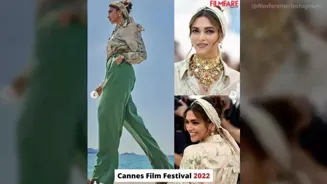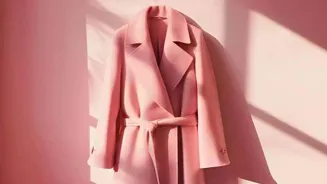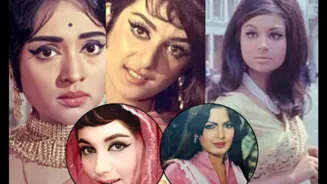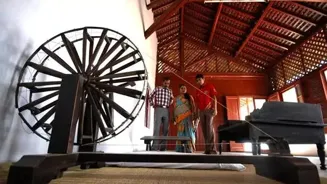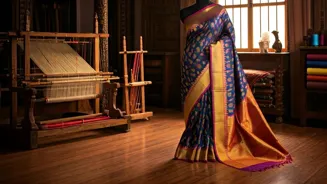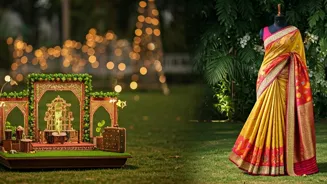Discover the captivating journey of Indian fashion from grace to glamor! Dive into how styles evolved over a century
From the elegant sarees of the early 1900s to the fusion wear of today, Indian fashion
has truly undergone a massive transformation. It's a journey reflecting social changes, economic shifts, and the increasing influence of global trends.
Buckle up as we take a colourful ride through the ever-evolving world of Indian style!
Early 20th century fashion: grace, tradition, simplicity in clothing
The early 20th century was all about grace and tradition. Women primarily wore sarees, often handwoven with intricate designs and rich fabrics like silk and cotton. Blouses were simple and modest, usually covering the upper body completely.
Jewellery played a crucial role, with heavy gold necklaces, bangles, and earrings being essential adornments. For men, the attire consisted mainly of dhotis and kurtas, reflecting their regional culture and social status.
Western influence was minimal, limited to the elite class who occasionally adopted tailored suits or long gowns. The focus was very clear: comfort, practicality, and adherence to cultural norms. Simplicity was key and any kind of elaborate design was limited only to the upper class.
The common man adopted what was available in the local market.
Mid-20th century fashion evolution influenced by nationalism and Bollywood
The mid-20th century saw the winds of change picking up speed. The independence movement and the subsequent rise of nationalism had a significant impact on fashion. Khadi, a hand-spun fabric promoted by Mahatma Gandhi, became a symbol of self-reliance and national pride.
Women started experimenting with blouse designs, introducing variations like puffed sleeves and deeper necklines. Salwar kameez, a practical and comfortable alternative to the saree, gained popularity, especially in North India.
Western styles like dresses and skirts, though still not mainstream, slowly made their presence felt in urban areas. Bollywood started to influence fashion.
Actresses like Madhubala and Nargis became style icons, inspiring women across the country with their elegant sarees and sophisticated hairstyles. The influence of the west slowly grew, mostly in the urban areas.
Late 20th century fashion trends; synthetic fabrics, Bollywood influence, rise of designers
The late 20th century witnessed a fashion explosion! The arrival of synthetic fabrics like polyester and rayon made clothing more affordable and accessible. Bell-bottoms and platform shoes, inspired by Western trends, became the rage among youngsters.
Bollywood continued to be a major influence, with actresses like Zeenat Aman and Parveen Babi popularizing glamorous and often revealing outfits. The saree, however, retained its significance, with designers introducing new drapes and embellishments.
The rise of Indian designers like Ritu Kumar and Manish Malhotra marked the beginning of a more professional and innovative fashion industry. The economic boom of the late 1990s further fueled the fashion scene, with increased consumer spending and greater exposure to international brands.
Globalization shapes modern Indian fashion trends
The 21st century is all about fusion and experimentation. Globalization has brought Indian fashion to the world stage, and vice versa. Designers are blending traditional Indian crafts with modern silhouettes, creating unique and innovative designs.
The salwar kameez has evolved into various styles, including the Anarkali suit and the palazzo suit. Jeans and t-shirts have become wardrobe staples for both men and women. The influence of social media is undeniable, with fashion bloggers and influencers shaping trends and inspiring millions.
Sustainability and ethical fashion are also gaining traction, with consumers becoming more conscious of the environmental and social impact of their clothing choices. Indian fashion has become diverse, catering to a wide range of tastes and preferences.
Indian fashion: diverse, evolving with fusion styles, embracing innovation and cultural exchange
Today, Indian fashion is as diverse as the country itself. From the traditional elegance of the saree to the modern chic of Indo-Western outfits, there's something for everyone. Designers are constantly pushing boundaries, experimenting with new fabrics, silhouettes, and embellishments.
The fashion industry is booming, creating jobs and opportunities for talented individuals. The future of Indian fashion looks bright, with a continued focus on innovation, sustainability, and cultural representation. The styles are more bold today.
This evolution is visible in the way designers bring styles from the west to Indian traditional wear and vice versa. It is beautiful to see people accept things from different cultures as it is a form of respect.
Indian fashion embracing tech, customization, sustainability for global leadership
Looking ahead, Indian fashion is poised for even greater innovation. Technology is playing a bigger role, with 3D printing and virtual reality opening up new possibilities for design and production.
Customization is also becoming increasingly popular, allowing consumers to create clothing that perfectly fits their body and style. Sustainability will continue to be a driving force, as designers and consumers alike seek to minimize the environmental impact of the fashion industry.
Indian fashion has the potential to be a global leader in sustainable and ethical practices.

